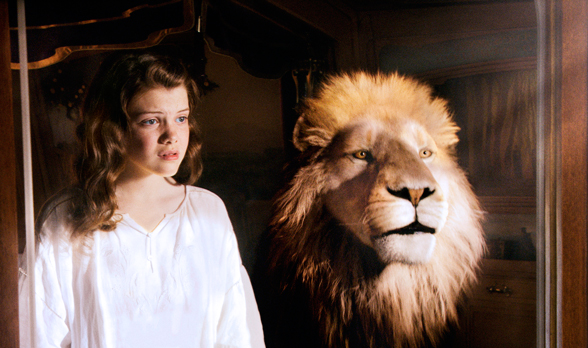by John P. McCarthy

NEW YORK (CNS) – In “Porta Fidei” (“The Door of Faith”), an apostolic letter announcing the current Year of Faith, Pope Benedict XVI urges us to study the history of Catholicism, which he describes as “marked by the unfathomable mystery of the interweaving of holiness and sin.”
This striking observation also can apply to the medium of film. All too often in movies, however, sin dominates, and holiness is difficult to recognize.
In the spirit of the new evangelization, the Year of Faith, which runs through Nov. 24, is an appropriate time to ask what constitutes a faithful and, more specifically, a Catholic movie. If the definitions are too narrow, few films will make the grade; if too broad, the designations themselves will become meaningless.
Movies seeking to embody the tenets of a particular religious tradition, explain one of its sacred texts or profile a key prophet are the easiest to classify in this way. Admiring portraits of clerics, converts, laypeople or other believing protagonists are also strong candidates, as are films that use storytelling techniques, such as allegory, to impart an article of faith.
Turning to Catholic films, there are many reasons a picture might be deemed Catholic. But the dynamic between those who create a work, the work itself and the audience beholding it is a useful shortcut. A movie may qualify as Catholic if the filmmaker has a Catholic sensibility, if the subject matter – plot, personae or setting – involves Catholicism and/or if a viewer offers a plausible Catholic interpretation.
Adducing meaning in a film by reference to the filmmaker’s intentions and outlook is problematic because cinema is such a collaborative medium. Still, provided they are manifested on screen, a filmmaker’s aims and sensibility are a rich source of interpretive material.
The pantheon of Catholic directors, lapsed and devout, includes Robert Bresson, Luis Bunuel, Frank Capra, Francis Ford Coppola, Federico Fellini, Alfred Hitchcock, Pier Paolo Pasolini, Martin Scorsese and Andrei Tarkovsky.
Of course, not every one of their films is Catholic, and not every film with a Catholic theme, plot, setting or protagonist qualifies either. A minimum amount of respect for the Catholic subject matter must be evinced, even if strong doubts are expressed and considerable ambiguity permitted.
The range of examples stretches from Carl Theodor Dreyer’s silent masterwork The Passion of Joan of Arc (1928) and popular entertainments from Hollywood’s Golden Age – Bible epics and certain Bing Crosby vehicles, for instance – to more recent fare. The latter includes the biopic Romero (1989), The Chronicles of Narnia series (2005-10), the documentary Into Great Silence (2007) and the French film Of Gods and Men (2011).
When assessing subject matter, movies blatantly hostile to religion, patently heretical or obviously anti-Catholic are readily disqualified. Those that merely pay lip service to religious faith or peddle watered-down beliefs are nearly as easy to dismiss.
While better than many alternatives, what passes for religiosity in most mainstream movies is too shallow and generic to leave a deep impression. Humanism, non-specific ethical concerns and advocacy of a vaguely spiritual, less materialistic approach to life are not enough.
Several recently released films illustrate this point. As a boy, the title character in Life of Pi embarks on a personal quest to find God, picking and choosing from a number of different faiths, including Catholicism. Yet, as his atheist father remarks, “Believing in everything is like believing in nothing.”
In The Sessions – a drama in which a Catholic priest encourages a paraplegic member of his flock to have relations with a so-called sex surrogate – a young woman, asked if she’s religious, replies, “I don’t think about God much but I do believe there’s a mysterious logic or poetry to life.” This line succinctly expresses the type of soft, unthinking religiosity typically encountered at the multiplex.
Two other current releases underscore another important point. Steven Spielberg’s Lincoln and Quentin Tarantino’s Django Unchained address the immorality of slavery in different ways. Both want to entertain and enlighten audiences about historical realities. Yet, along with its revenge narrative, the graphic violence, obscene language and exploitative tenor of Tarantino’s latest film undercuts any salubrious message.
Although completely separating form and content is impossible, when attempting to fathom an artwork we tend to focus on the “how” more than the “what.” Style and tone convey as much, and sometimes more, than action and dialogue.
At this juncture the viewer’s act of interpretation becomes decisive. A movie can be deemed authentically Catholic through description and evaluation presented from a Catholic perspective.
Offering a convincing Catholic interpretation that accurately reflects form and content, and possibly the sensibility and intentions of a movie’s creators, requires a certain manner of discernment. The interpreter must train a Catholic imagination on the film and be committed to reading it through that prism.
That said, each movie must be considered on its own merits without bias or preconceptions. Valid judgments can only be made after engaging with a film on its own terms. This must be followed by reflection and analysis in which sound critical method, clear values and personal experiences are brought to bear.
A movie is authentically Catholic when its Catholic traits are fully integrated into its form and content. Such integrity is similar to that perceived in a person whose beliefs and behavior always appear to be in concert, someone we can justly say “lives their faith.”
This critical process is analogous to the task Pope Benedict calls us to undertake regarding the history of the Church during the Year of Faith. The question is not whether holiness and sin are intertwined in our faith, in ourselves and in what we create. We are challenged to discern how they are woven together – and to begin unspooling the mystery of why.[hr] John P. McCarthy is a guest reviewer for Catholic News Service.
